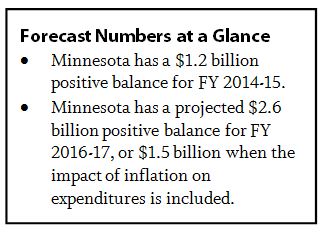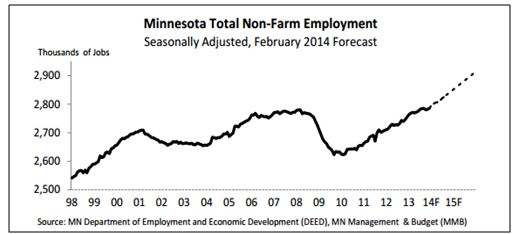The February 2014 Economic Forecast brought good news. Minnesota continues to be in positive budget territory, with a $1.2 billion positive balance in the current budget cycle, FY 2014-15.[1] The state’s economy is also improving and performing better than the U.S. economy. However, policymakers should act cautiously with this good news. The positive balance is a sign that the state has more funds than anticipated, but not necessarily more than is needed.

In the 2013 Legislative Session, policymakers ended a cycle of frequent deficits, made our tax system more fair, and made crucial investments in education, affordable college education, and other building blocks of our economy. Policymakers should use the surplus to maintain this course. They should take additional steps for tax fairness, build the state’s budget reserves, and make targeted investments for a more prosperous future, especially for those left out of the current recovery.
The forecast shows that Minnesota’s economy is making solid gains. At the end of 2013, unemployment was two percentage points lower than the national rate, and Minnesota’s jobs numbers have climbed above pre-recession levels. Consumer confidence, which the forecast notes is key to economic growth, is also up to “near recovery highs.”
That strong economic growth contributes to a stronger financial situation for the state. The forecast projects a $1.2 billion positive balance in the current budget cycle, and the good news continues into the next biennium. The forecast projects a $2.6 billion positive balance for FY 2016-17. Taking the impact of inflation on expenditures into account decreases the positive balance to $1.5 billion.

The state’s economic forecasts are a critical tool that policymakers and the public use to measure the state’s fiscal health and assess spending and tax proposals. Minnesota Management and Budget prepares forecasts each November and February. State, national and global economic trends are used to estimate Minnesota’s future revenues and expenditures under current laws on taxes and spending.
Higher Revenues and Lower Spending Create a Positive Balance
The strong positive balance of $1.2 billion in the current budget cycle comes from projections of both higher revenues and lower spending. Stronger economic growth is expected to bring in higher income and sales tax collections than were expected in the November forecast. On the spending side, the savings are primarily due to lower projections for E-12 education spending and property tax aids and credits.
Looking out to the next budget cycle, the forecast overstates the positive news. The official forecast figures have left out the impact of inflation on spending for a decade now, which underestimates what it will cost in the future to maintain current levels of services. Failing to include the impact of inflation also makes it tempting to make tax and budget decisions that are not ultimately sustainable. The state’s Council of Economic Advisors has recommended that Minnesota include inflation in its planning estimates so that they provide a more useful guide to policymaking.
Economic Improvement Expected, But Not Guaranteed
The national economy is recovering, and the forecast predicts faster growth next year, with 2.7 percent growth in GDP. Forecasters assign a 60 percent probability that this baseline economic forecast will be accurate. The forecast warns that the picture could change. Forecasters assign a 20 percent chance to a more pessimistic scenario where there is both “unwarranted fiscal tightening” at the federal level and a worsening global economy, barely avoiding another recession. They also assign a 20 percent probability to a more optimistic scenario where “less policy uncertainty lifts business confidence,” which encourages hiring and investing. In the more optimistic scenario, higher wage growth leads to more consumer spending, a faster housing recovery and more economic growth.
Minnesota is on a Better Track
Tax and budget decisions in the 2013 Legislative Session made important progress on raising enough revenues to meet our spending commitments, making targeted new investments for a more prosperous future, and basing our tax system more on income. This session, policymakers should maintain this improved course by:
- Making fairness a priority in tax decisions.
- Building our budget reserves.
- Targeting spending in areas that support Minnesotans left out of the recovery.
While the 2013 tax bill made significant progress on tax fairness, low- and moderate-income Minnesotans still pay a higher share of their incomes in state and local taxes than those with the highest incomes. Policymakers should maintain a focus on ensuring that low- and moderate-income Minnesotans aren’t paying more than their fair share to support public services. One good step forward would be to update the state’s Working Family Tax Credit to adopt recent federal improvements.
Policymakers should also strengthen our budget reserves to prepare for the next downturn in the business cycle. Adequate reserves soften the shock of future budget shortfalls. Minnesota has filled its budget reserves to the level required by law. However, Minnesota Management and Budget recommends reserves of $1.9 billion for the FY 2014-15 biennium, so that the state is well prepared for the next economic downturn.[2] Current budget reserves of $661 million and a cash flow account of $350 million only amount to half of this figure.
Finally, policymakers should use some of the surplus for targeted investments in a future of opportunity for all Minnesotans, including those who are left behind in the economic recovery.
In order to make this progress, policymakers should resist large tax cuts that significantly reduce state revenues and threaten our ability to invest in quality schools, affordable education and training opportunities, and other components of economic success. Minnesota’s recent history demonstrates that when the state does too much tax cutting in good times, it makes the hard times worse, resulting in deeper cuts in services and failing to meet the needs of those hardest hit when the next economic downturn comes along.
The February forecast brought our state some good news, but policymakers should act cautiously. They should continue efforts for a fair tax system, strengthen state budget reserves, and invest in a future of shared prosperity to make sure Minnesota stays on a solid track.
By Caitlin Biegler